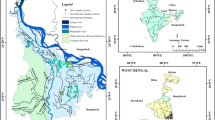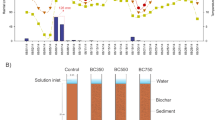Abstract
A 9-month-long continuous flow column study was carried out to investigate Cr(VI) removal by Fe0 with the presence of humic acid. The study focused on the influences of humic acid promoted dissolved iron release and humic acid aggregation in Fe0 columns receiving synthetic Cr(VI) contaminated groundwater containing various components such as bicarbonate and Ca. The effects of humic acid varied significantly depending on the presence of Ca. In Ca-free columns, the presence of humic acid promoted the release of dissolved iron in the forms of soluble Fe-humic acid complexes and stabilized fine Fe (hydr)oxide colloids. As a result, the precipitation of iron corrosion products was suppressed and the accumulation of secondary minerals on Fe0 surfaces was diminished, and a slight increase in Cr(VI) removal capacity by 18% was record compared with that of humic acid-free column. In contrast, in the presence of Ca, as evidenced by the SEM and FTIR results, humic acid greatly co-aggregated with Fe (hydr)oxides and deposited on Fe0 surfaces. This largely inhibited electron transfer from Fe0 surfaces to Cr(VI) and reduced the drainable porosity of the Fe0 matrix, resulting in a significant decrease in Cr(VI) removal capacity of Fe0. The Cr(VI) removal capacity was decreased by 24.4% and 42.7% in humic acid and Ca receiving columns, with and without bicarbonate respectively, compared with that of Ca and humic acid-free column. This study yields new considerations for the performance prediction and design of Fe0 PRBs in the environments rich in natural organic matter (NOM).



Similar content being viewed by others
References
Blowes, D. W., Ptacek, C. J., & Jambor, J. L. (1997). In-situ remediation of Cr(VI)-contaminated groundwater using permeable reactive walls: laboratory studies. Environmental Science & Technology, 31, 3348–3357.
Cantrell, K. J., Kaplan, D. I., & Wietsma, T. W. (1995). Zero-valent iron for the in-situ remediation of selected metals in groundwater. Journal of Hazardous Materials, 42, 201–212.
Castro, E. B., Vilche, J. R., & Arvia, A. J. (1991). Iron dissolution and passivation in K2CO3–KHCO3 solutions: Rotating ring disc electrode and xps studies. Corrosion Science, 32, 37–50.
Dries, J., Bastiaens, L., Springael, D., Kuypers, S., Agathos, S. N., & Diels, L. (2005). Effect of humic acids on heavy metal removal by zero-valent iron in batch and continuous flow column systems. Water Research, 39, 3531–3540.
Duan, J., & Gregory, J. (2003). Coagulation by hydrolyzing metal salts. Advances In Colloid And Interface Science, 100–102, 475–502.
Eary, L. E., & Rai, D. (1988). Chromate removal from aqueous wastes by reduction with ferrous ion. Environmental Science & Technology, 22, 972–977.
Gillham, R. W., & O’ Hannesin, S. F. (1994). Enhanced degradation of halogenated aliphatics by zero-valent iron. Ground Water, 32, 958–967.
Gu, B., Schmitt, J., Chen, Z., Liang, L., & MaCarthy, J. F. (1994). Adsorption and desorption of natural organic matter on iron oxide mechanisms and models. Environmental Science & Technology, 28, 38–46.
Gu, B., Phelps, T. J., Liang, L., Dickey, M. J., Roh, Y., Kinsall, B. L., et al. (1999). Biogeochemical dynamics in zero-valent iron columns: Implications for permeable reactive barriers. Environmental Science & Technology, 33, 2170–2177.
Kamolpornwijit, W., Liang, L., West, O. R., Moline, G. R., & Sullivan, A. B. (2003). Preferential flow path development and its influence on long term PRB performance: Column study. Journal of Contaminant Hydrology, 66, 161–178.
Klausen, J., Vikesland, P. J., Kohn, T., Burris, D. R., Ball, W. P., & Roberts, A. L. (2003). Longevity of granular iron in groundwater treatment processes: Solution composition effects on reduction of organohalides and nitroaromatic compounds. Environmental Science & Technology, 37, 1208–1218.
Lai, K. C. K., & Lo, I. M. C. (2008). Removal of chromium(VI) by acid-washed zero-valent iron under various groundwater geochemistry conditions. Environmental Science & Technology, 42, 1238–1244.
Legrand, L., Figuigui, A. E., Mercier, F., & Chausse, A. (2004). Reduction of aqueous chromate by Fe(II)/Fe(III) carbonate green rust: Kineic and mechanistic studies. Environmental Science & Technology, 38, 4587–4595.
Liu, T., Tsang, D. C. W., & Lo, I. M. C. (2008). Chromium(VI) reduction kinetics by zero-valent iron in moderately hard water with humic acid: Iron dissolution and humic acid adsorption. Environmental Science & Technology, 42, 2092–2098.
Lo, I. M. C., Lam, C. S. C., & Lai, K. C. K. (2006). Hardness and carbonate effects on the reactivity of zero-valent iron for Cr(VI) removal. Water Research, 40, 595–605.
Powell, R. M., Puls, R. W., Hightower, S. K., & Sabatini, D. A. (1995). Coupled iron corrosion and chromate reduction: mechanisms for subsurface remediation. Environmental Science & Technology, 29, 1913–1922.
Pratt, A. R., Blowes, D. W., & Ptacek, C. J. (1997). Products of chromate reduction on proposed subsurface remediation material. Environmental Science & Technology, 31, 2492–2498.
Roh, Y., Lee, S. Y., & Elless, M. P. (2000). Characterization of corrosion products in the permeable reactive barriers. Environ Geo, 40, 184–194.
Saito, T., Koopal, L. K., van Riemsdijk, W. H., Nagasaki, S., & Tanaka, S. (2004). Adsorption of humic acid on goethite: Isotherms, charge adjustments, and potential profiles. Langmuir, 20, 689–700.
Snoeyink, V. L., & Jenkins, D. (1980). Water chemistry. New York: Wiley.
Thurman, E. M. (1985). Organic geochemistry of natural waters. Dordrecht: Martnus Nijhoff/Junk.
Tipping, E. (2002). Cation binding by humic substances. Cambridge: Cambridge University Press.
Tratnyek, P. G., Scherer, M. M., Deng, B., & Hu, S. (2001). Effects of natural organic matter, anthropogenic surfactants, and model quinones on the reduction of contaminants by zero-valent iron. Water Research, 35, 4435–4443.
USEPA. (1998). Permeable Reactive Barrier Technologies for Contaminant Remediation. EPA/600/R-98/125.
VanGulck, J. F., & Rowe, R. K. (2004). Evolution of clog formation with time in columns permeated with synthetic landfill leachate. Journal of Contaminant Hydrology, 75, 115–139.
von der Kumpulainen, S., Kammer, F., & Hofmann, T. (2008). Humic acid adsorption and surface charge effects on schwertmanite and goethite in acid sulphate waters. Water Research, 42, 2051–2060.
Weng, L. P., Koopal, L. K., Hiemstra, T., Meeussen, J. C. L., & van Riemsdijk, W. H. (2005). Interactions of calcium and fulvic acid at the goethite-water interface. Geochimica et Cosmochimica Acta, 69, 325–339.
Wilkin, R. T., Su, C., Ford, R. G., & Paul, C. J. (2005). Chromium-removal processes during groundwater remediation by a zerovalent iron permeable reactive barrier. Environmental Science & Technology, 39, 4599–4605.
Williams, A. G. B., & Scherer, M. M. (2001). Kinetic of Cr(VI) reduction by carbonate green rust. Environmental Science & Technology, 35, 3488–3494.
Xie, L., & Shang, C. (2005). Role of humic acid and quinone model compounds in bromate reduction by zerovalent iron. Environmental Science & Technology, 39, 1092–1100.
Acknowledgment
This work was supported by the Hong Kong Research Grants Council under grant HKUST RGC 617006.
Supporting Information
Additional one table, nine figures and information of two supplementary experiments are available online.
Author information
Authors and Affiliations
Corresponding author
Electronic Supplementary Materials
Below is the link to the electronic supplementary material.
ESM 1
(PDF 479 kb)
Rights and permissions
About this article
Cite this article
Liu, T., Lo, I.M.C. Influences of Humic Acid on Cr(VI) Removal by Zero-Valent Iron From Groundwater with Various Constituents: Implication for Long-Term PRB Performance. Water Air Soil Pollut 216, 473–483 (2011). https://doi.org/10.1007/s11270-010-0546-2
Received:
Accepted:
Published:
Issue Date:
DOI: https://doi.org/10.1007/s11270-010-0546-2




